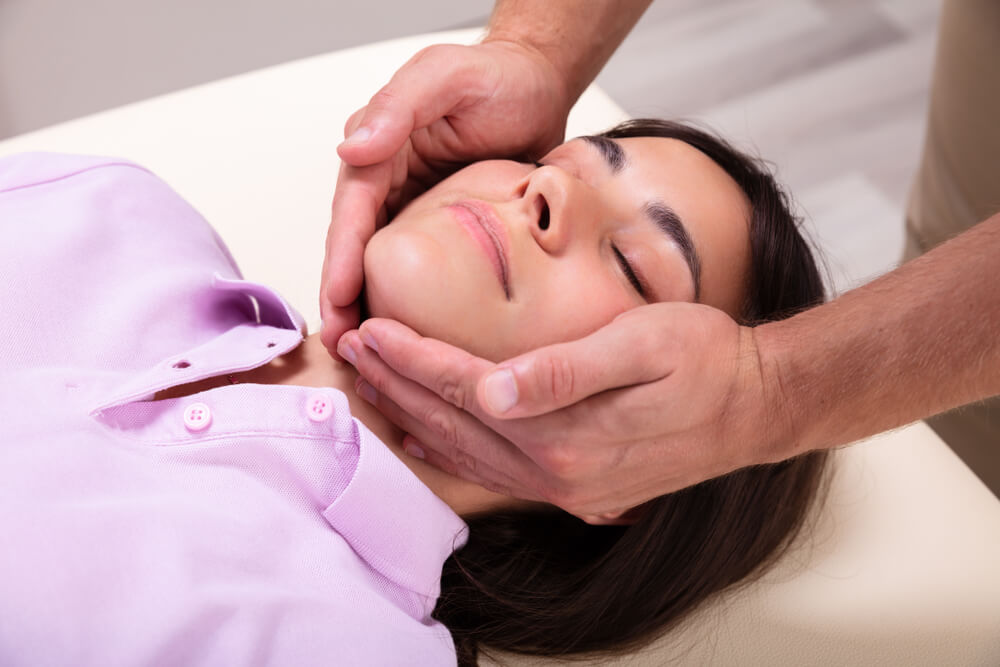Physio for TMJ – Temporomandibular Joint Dysfunction
TMJ (Temporomandibular Joint) dysfunction is a condition that consists of a set of symptoms presented in the TMJ, the area around the two joints connecting your jaw bone and mandible to the temporal bone of the skull.
TMJ symptoms include pain, muscle spasms, and locking the jaw in a position that makes it painful to move. Symptoms may progress to include headache and dizziness.
The first typical sign of TMJ is a painful jaw. There is no reason to panic if you notice that your jaw hurts, pops or clicks when you speak or chew. A professional physiotherapist can assign effective treatment to heal this debilitating condition.
What Causes a Dysfunctional TMJ
If you don’t know what you’re dealing with, TMJ dysfunction initiates discomfort because it is located in a sensitive head area near the ears, eyes, and teeth. However, there is no need to let TMJ dysfunction prevent you from enjoying life once you learn why your jaw hurts.
The TMJ is one of the more complex joints in your body. It is made of the articular disc (a thin oval plate) and two bones. The TMJ joint moves in two halves of one movement. In the first phase, the mandible makes a circular spinning motion inside the joint. In the second translational phase, the mandible and the articular disc slide forward on the temporal bone to come to a full opening.
When there is misalignment between the joints during this movement, the jaw starts hurting and presents additional TMJ symptoms which require physical therapy.
Benefits of Physio for TMJ
Physio for TMJ targets the causes – poor posture, teeth grinding, trauma, yawning or eating habits – by developing a set of stretching and strengthening exercises for the weak TMJ area, manual therapy, prescribing painkillers, and making suggestions about adjusting your workstation and car seat.
Physio for TMJ – Strengthening
TMJ dysfunction in some patients is an outcome of how they eat and speak. Moving your jaw too fast or too forcefully can misplace the temporomandibular joint and cause pain. A trained physiotherapist can notice improper movements and advise how to make improvements.
Improving TMJ Range of Motion
TMJ stiffness caused by past trauma requires attention from the physiotherapist in the shape of manual therapy techniques. The TMJ physiotherapist will loosen the stiffness to get the joint to move naturally. You will get instructions for exercises to do between visits to maintain the improved range of motion.
Muscle Spasm Treatment
By using their knowledge in anatomy, physiotherapists assess the muscles of the TMJ and how you move them. Muscle spasms prevent your joint from healing. Your physio clinic can assist you with manual therapy techniques for improving joint alignment.
Posture Changes
Poor posture shortens muscles, making it difficult for some people to move the head and the jaw properly forward. After a while, the posture causes TMJ pain. A licensed physio professional can observe what movements contribute to the pain, recommend posture corrections, and teach stretching and strengthening exercises that will ultimately improve your body position.
TMJ Dysfunction Pain Relief
Some patients need instant relief because they are in a lot of pain and cannot address the TMJ condition with exercises or postural changes. In that case, the patient’s pain is relieved by gentle manual physio, thermal therapeutic modalities, ultrasound, and acupuncture.
Dental Care for TMJ Pain
Your physiotherapist may work alongside a dental expert to advise relaxation techniques for a clenched jaw, a nightguard to prevent you from grinding your teeth, or prescribing medications such as analgesics, relaxants, and anti-inflammatory drugs. Eating softer foods, stop biting your nails, and avoiding chewing gum is among the techniques that can help TMJ dysfunction pain.
Best Exercises for TMJ
This regimen will be put on the list of most helpful exercises to improve jaw mobility, strengthen jaw muscles, relax the TMJ area, and reduce clicking and popping sounds.
- Goldfish opening exercises
- Chin tucks
- Resisted mouth closing and opening
- Tongue-on-the-roof
- Side to side jaw movement
- Forward jaw movement
Ice packs or heat pads can reduce sharp pain that prevents you from doing exercises. Many mild TMJ disorders go on their own. But if you don’t see any improvements or the TMJ dysfunction results from a trauma such as a fracture, cooperating with your physiotherapist can significantly speed up recovery to feeling your best self.

